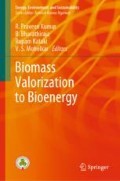Abstract
Agro-industries produce large amounts of various forms of waste, which come out from processing activities and waste management processes. The wastes generated may be multi-phase and may consist of multi-component. The amount, characterization and composition of this waste depend on the raw material sources, product types, and processes. Agro-industries, more specifically food industrial wastes, consist of great amount of organic matters which are rich in nutrient content, with higher values of BOD, COD and TSS. If agro-industrial wastes are not correctly treated, they may cause severe pollution problems. Besides, they represent a loss of valuable biomass and nutrients. The present book chapter reviews the various characteristics of pollution management problems of different agro-industries. In many agro-industries, water pollution is a serious threat as compared to solid wastes which have the possibilities for recovery of value added products. Various possible sources and impacts of different agro-industrial wastes on the environment are extensively reviewed. The possible ways of meting out of biomass and inhibition of micro-organism using Biorefinery principles and its challenges are also explored. The bio-refineries can reproduce an oil refinery by means of a bio-refinery using renewable biomass for the manufacturing different products. The possible future of technological developments in order to improve the quality of people’s life and sustaining our environment by using clean bioprocess technologies and its future aspects are also explained. The present book chapter elaborately describes about the key activity of clean technology ‘recycling’ of agro-industrial waste that is deliberately important as it utilizes the integrated approach of waste minimization which guides to biological industrial complex where a group of industries share possible resources and recycling of wastes. This book chapter review highlights the application of bio-refinery concept on wastes obtained from the agro-industries.
Access this chapter
Tax calculation will be finalised at checkout
Purchases are for personal use only
References
Aruldass CA, Aziz A, Venil CK, Khasim AR, Ahmad WA (2016) Utilization of agro-industrial waste for the production of yellowish orange pigment from Chryseobacterium artocarpi CECT 8497. Int Biodeterior Biodegrad 113:342–349. https://doi.org/10.1016/j.ibiod.2016.01.024
Bharathiraja S, Suriya J, Krishnan M, Manivasagan P, Kim SK (2017) Production of enzymes from agricultural wastes and their potential industrial applications. Adv Food Nutr Res 80:125–148
Esteban J, Ladero M (2018) Food waste as a source of value-added chemicals and materials: a biorefinery perspective. Int J Food Sci Technol 53:1095–1108. https://doi.org/10.1111/ijfs.13726
Galanakis CM (2012) Recovery of high added-value components from food wastes: conventional, emerging technologies and commercialized applications. Trends Food Sci Technol 2:68–87
Gonzalez-Garci S, Gullo B, Rivas S, Feijoo G, Moreira MT (2016) Environmental performance of biomass refining into high-added value compounds. J Clean Prod 120:170–180
Gonzalez-Garci S, Gullo B, Moreira MT (2017) Environmental assessment of biorefinery processes for the valorization of lignocellulosic wastes into oligosaccharides. J Clean Prod. Available from: https://doi.org/10.1016/j.jclepro.2017.02.164
Govindaraj D, Rajan M, Hatamleh AA, Munusamy MA (2017) From waste to high value product: Jackfruit peel derived pectin/apatite bionanocomposites for bone healing applications. Int J Biol Macromol. https://doi.org/10.1016/jijbiomac.2017.08.017 (in press)
Jecu L (2000) Solid state fermentation of agricultural wastes for endoglucanase production. Ind Crop Prod 1:1–5
Kim S, Dale BE (2004) Global potential bioethanol production from wasted crops and crop residues. Biomass Bioenergy 26:361–375
Kumar K, Yadav AN, Kumar V, Vyas P, Dhaliwal HS (2017) Food waste: a potential bioresource for extraction of nutraceuticals and bioactive compounds. Bioresour Bioprocess 1:18
Luchese CL, Sperotto N, Spada JC, Tessaro IC (2017) Effect of blueberry agro-industrial waste addition to corn starch–based films for the production of a pH-indicator film. Int J Biol Macromol 104:11–18. https://doi.org/10.1016/j.ijbiomac.2017.05.149
Panesar R, Kaur S, Panesar PS (2015) Production of microbial pigments utilizing agro-industrial waste: a review. Curr Opin Food Sci 1:70–76
Salim AA, Grbavčić S, Šekuljica N, Stefanović A, Tanasković SJ, Luković N, Knežević-Jugović Z (2017) Production of enzymes by a newly isolated Bacillus sp. TMF-1 in solid state fermentation on agricultural by-products: the evaluation of substrate pretreatment methods. Bioresour Technol 228:193–200
Sarkar N, Ghosh SK, Bannerjee S, Aikat K (2012) Bioethanol production from agricultural wastes: an overview. Renew Energy 37:19–27
Tonini D, Hamelin L, Astrup TF (2016) Environmental implications of the use of agro-industrial residues for biorefineries: application of a deterministic model for indirect land-use changes. GCB Bioenergy 8:690–706
Venglovsky J, Martinez J, Placha I (2006) Hygienic and ecological risks connected with utilization of animal manures and biosolids in agriculture. Livest Sci 102:197–203
Yusuf M (2017) Agro-industrial waste materials and their recycled value-added applications: review. In: Martínez LMT et al (eds) Handbook of ecomaterials. Springer International Publishing AG. https://doi.org/10.1007/978-3-319-48281-1_48-1
Yusuf M, Shahid M, Khan MI, Khan SA, Khan MA, Mohammad F (2015) Dyeing studies with henna and madder: a research on effect of tin (II) chloride mordant. J Saudi Chem Soc 1:64–72
Yusuf M, Khan SA, Shabbir M, Mohammad F (2016) Developing a shade range on wool by madder (Rubia cordifolia) root extract with gallnut (Quercus infectoria) as biomordant. J Nat Fibers 4:597–607
Yusuf M, Shabbir M, Mohammad F (2017) Natural colorants: historical, processing and sustainable prospects. Nat Prod Bioprospect 1:123–145
Author information
Authors and Affiliations
Corresponding author
Editor information
Editors and Affiliations
Rights and permissions
Copyright information
© 2020 Springer Nature Singapore Pte Ltd.
About this chapter
Cite this chapter
Senthilkumar, K., Naveen Kumar, M., Chitra Devi, V., Saravanan, K., Easwaramoorthi, S. (2020). Agro-Industrial Waste Valorization to Energy and Value Added Products for Environmental Sustainability. In: Praveen Kumar, R., Bharathiraja, B., Kataki, R., Moholkar, V. (eds) Biomass Valorization to Bioenergy. Energy, Environment, and Sustainability. Springer, Singapore. https://doi.org/10.1007/978-981-15-0410-5_1
Download citation
DOI: https://doi.org/10.1007/978-981-15-0410-5_1
Published:
Publisher Name: Springer, Singapore
Print ISBN: 978-981-15-0409-9
Online ISBN: 978-981-15-0410-5
eBook Packages: Earth and Environmental ScienceEarth and Environmental Science (R0)

